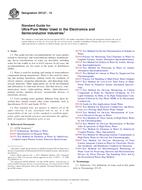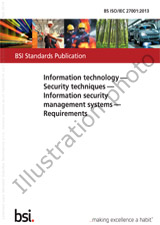We need your consent to use the individual data so that you can see information about your interests, among other things. Click "OK" to give your consent.
ASTM D5127-13
Standard Guide for Ultra-Pure Water Used in the Electronics and Semiconductor Industries
STANDARD published on 1.1.2013
The information about the standard:
Designation standards: ASTM D5127-13
Note: WITHDRAWN
Publication date standards: 1.1.2013
SKU: NS-29934
The number of pages: 6
Approximate weight : 18 g (0.04 lbs)
Country: American technical standard
Category: Technical standards ASTM
The category - similar standards:
Water for industrial useOther products of the chemical industry
Annotation of standard text ASTM D5127-13 :
Keywords:
electronic, microelectronics, semiconductor, ultra-pure water, ICS Number Code 13.060.25 (Water for industrial use), 71.100.99 (Other products of the chemical industry)
Additional information
| Significance and Use | |||||||
|
4.1 This guide recommends the water quality required for the electronics and microelectronics industries. High-purity water is required to prevent contamination of products during manufacture, since contamination can lead to an unacceptable, low yield of electronic devices. 4.2 The range of water purity is defined in accordance with the manufacturing process. The types of ultra-pure water are defined with respect to device line width. In all cases, the water-quality recommendations apply at the point of distribution. 4.3 The limits on the impurities are related to current contamination specifications and to available analytical methods (either performed in a suitable clean laboratory or by on-line instrumentation). On-line and off-line methods are used in accordance with current industry practice. Concentration of the sample may be required to measure the impurities at the levels indicated in Parameter |
Type E-1 |
Type E-1.1 |
Type E-1.2B |
Type E-1.3B |
Type E-2 |
Type E-3 |
Type E-4 |
|
Linewidth (microns) |
1.0–0.5 |
0.35–0.25 |
0.18–0.09 |
0.065–0.032 |
5.0–1.0 |
>5.0 |
— |
|
Resistivity, 25°C (On-line) |
18.1 |
18.2 |
18.2 |
18.2 |
16.5 |
12 |
0.5 |
|
TOC (μg/L) (on-line for <10 ppb) |
5 |
2 |
1 |
1 |
50 |
300 |
1000 |
|
On-line dissolved oxygen (μg/L) |
25 |
10 |
3 |
10 |
— |
— |
— |
|
On-Line Residue after evaporation (μg/L) |
1 |
0.5 |
0.1 |
|
— |
— |
— |
|
On-line particles/L (micron range) |
|
|
|
|
|
|
|
|
>0.05 μm |
|
|
|
500 |
|
|
|
|
0.05–0.1 |
|
1000 |
200 |
N/A |
— |
— |
— |
|
0.1–0.2 |
1000 |
350 |
<100 |
N/A |
— |
— |
— |
|
0.2–0.5 |
500 |
<100 |
<10 |
N/A |
— |
— |
— |
|
0.5-1.0 |
200 |
<50 |
<5 |
N/A |
— |
— |
— |
|
1.0 |
<100 |
<20 |
<1 |
N/A |
— |
— |
— |
|
SEM particles/L (micron range) |
|
|
|
|
|
|
|
|
0.1–0.2 |
1000 |
700 |
<250 |
N/A |
— |
— |
— |
|
0.2–0.5 |
500 |
400 |
<100 |
N/A |
3000 |
— |
— |
|
0.5–1 |
100 |
50 |
<30 |
N/A |
— |
10 000 |
— |
|
10 |
<50 |
<30 |
<10 |
N/A |
— |
— |
100 000 |
|
Bacteria in CFU/Volume |
|
|
|
|
|
|
|
|
100 mL Sample |
5 |
3 |
1 |
N/A |
10 |
50 |
100 |
|
1 L Sample |
|
|
10 |
1 |
|
|
|
|
10 L Sample |
|
|
|
1 |
|
|
|
|
Silica – total (μg/L) |
5 |
3 |
1 |
0.5 |
10 |
50 |
1000 |
|
Silica – dissolved (μg/L) |
3 |
1 |
0.5 |
0.5 |
— |
— |
— |
|
Anions and Ammonium by IC (μg/L) |
|
|
|
|
|
|
|
|
Ammonium |
0.1 |
0.10 |
0.05 |
0.050 |
— |
— |
— |
|
Bromide |
0.1 |
0.05 |
0.02 |
0.050 |
— |
— |
— |
|
Chloride |
0.1 |
0.05 |
0.02 |
0.050 |
1 |
10 |
1000 |
|
Fluoride |
0.1 |
0.05 |
0.03 |
0.050 |
— |
— |
— |
|
Nitrate |
0.1 |
0.05 |
0.02 |
0.050 |
1 |
5 |
500 |
|
Nitrite |
0.1 |
0.05 |
0.02 |
0.050 |
— |
— |
— |
|
Phosphate |
0.1 |
0.05 |
0.02 |
0.050 |
1 |
5 |
500 |
|
Sulfate |
0.1 |
0.05 |
0.02 |
0.050 |
1 |
5 |
500 |
|
Metals by ICP/MS (μg/L) |
|
|
|
|
|
|
|
|
Aluminum |
0.05 |
0.02 |
0.005 |
0.001 |
— |
— |
— |
|
Antimony |
|
|
|
0.001 |
|
|
|
|
Arsenic |
|
|
|
0.001 |
|
|
|
|
Barium |
0.05 |
0.02 |
0.001 |
0.001 |
— |
— |
— |
|
BoronC |
0.3 |
0.1 |
0.05 |
0.050 |
— |
— |
— |
|
Cadmium |
|
|
|
0.010 |
|
|
|
|
Calcium |
0.05 |
0.02 |
0.002 |
0.001 |
— |
— |
— |
|
Chromium |
0.05 |
0.02 |
0.002 |
0.001 |
— |
— |
— |
|
Copper |
0.05 |
0.02 |
0.002 |
0.001 |
1 |
2 |
500 |
|
Iron |
0.05 |
0.02 |
0.002 |
0.001 |
— |
— |
— |
|
Lead |
0.05 |
0.02 |
0.005 |
0.001 |
— |
— |
— |
|
Lithium |
0.05 |
0.02 |
0.003 |
0.001 |
— |
— |
— |
|
Magnesium |
0.05 |
0.02 |
0.002 |
0.001 |
— |
— |
— |
|
Manganese |
0.05 |
0.02 |
0.002 |
0.010 |
— |
— |
— |
|
Nickel |
0.05 |
0.02 |
0.002 |
0.001 |
1 |
2 |
500 |
|
Potassium |
0.05 |
0.02 |
0.005 |
0.001 |
2 |
5 |
500 |
|
Sodium |
0.05 |
0.02 |
0.005 |
0.001 |
1 |
5 |
1000 |
|
Strontium |
0.05 |
0.02 |
0.001 |
|
— |
— |
— |
|
Tin |
|
|
|
0.010 |
|
|
|
|
Titanium |
|
|
|
0.010 |
|
|
|
|
Vanadium |
|
|
|
0.010 |
|
|
|
|
Zinc |
0.05 |
0.02 |
0.002 |
0.001 |
1 |
5 |
500 |
|
Temperature Stability (K) |
|
|
|
±1 |
|
|
|
|
Temperature Gradient (K/10 min) |
|
|
|
<0.1 |
|
|
|
|
Dissolved Nitrogen On-line (mg/L) |
|
|
|
8-18 |
|
|
|
|
Dissolved Nitrogen Stability (mg/L) |
|
|
|
±2 |
|
|
|
1.2 Water is used for washing and rinsing of semiconductor components during manufacture. Water is also used for cleaning and etching operations, making steam for oxidation of silicon surfaces, preparing photomasks, and depositing luminescent materials. Other applications are in the development and fabrication of solid-state devices, thin-film devices, communication lasers, light-emitting diodes, photo-detectors, printed circuits, memory devices, vacuum-tube devices, or electrolytic devices.
1.3 Users needing water qualities different from those described here should consult other water standards, such as Specification D1193 and Guide D5196.
1.4 This standard does not purport to address all of the safety concerns, if any, associated with its use. It is the responsibility of the user of this standard to establish appropriate safety and health practices and determine the applicability of regulatory limitations prior to use.
|
Standard Test Method for On-Line Determination of Sodium in Water |
|
|
Standard Terminology Relating to Water (Includes all amendments and changes 2/14/2024). |
|
|
Standard Test Method for Potassium in Water by Atomic Absorption Spectrophotometry |
|
|
Standard Test Method for Measuring Anionic Contaminants in High-Purity Water by On-Line Ion Chromatography |
|
|
Standard Test Method for On-Line Measurement of Residue After Evaporation of High-Purity Water |
|
|
Standard Test Methods for Trace Anions in High Purity Water by Ion Chromatography |
|
|
Standard Guide for Bio-Applications Grade Water |
|
|
Standard Test Method for Elements in Water by Inductively Coupled Plasma´Mass Spectrometry |
|
|
Standard Test Method for On-Line Measurement of Low-Level Dissolved Oxygen in Water |
|
|
Standard Practice for Handling of High Purity Water Samples |
|
|
Standard Test Method for Anions in Water by Suppressed Ion Chromatography |
|
|
Standard Test Method for Electrical Conductivity and Resistivity of a Flowing High Purity Water Sample |
|
|
Standard Guide for On-Line Monitoring of Total Organic Carbon in Water by Oxidation and Detection of Resulting Carbon Dioxide |
|
|
Standard Test Method for Low-Level Total Silica in High-Purity Water by Flameless Atomic Absorption Spectroscopy |
|
|
Standard Test Method for Sodium in Water by Atomic Absorption Spectrophotometry |
|
|
Standard Practice for Measuring Trace Elements in Water by Graphite Furnace Atomic Absorption Spectrophotometry |
|
|
Standard Test Method for Elements in Water by Inductively-Coupled Plasma Atomic Emission Spectroscopy |
|
|
Standard Specification for Reagent Water |
|
|
Standard Test Method for On-Line Monitoring of Total Carbon, Inorganic Carbon in Water by Ultraviolet, Persulfate Oxidation, and Membrane Conductivity Detection |
|
|
Standard Test Methods for Microbiological Monitoring of Water Used for Processing Electron and Microelectronic Devices by Direct Pressure Tap Sampling Valve and by the Presterilized Plastic Bag Method |
Similar standards:
14.10.2003
WITHDRAWN
31.12.2008
WITHDRAWN
30.6.2013
30.9.2008
30.6.2013
30.6.2013
We recommend:
Technical standards updating
Do you want to make sure you use only the valid technical standards?
We can offer you a solution which will provide you a monthly overview concerning the updating of standards which you use.
Would you like to know more? Look at this page.



 BS EN 12953-10:2003..
BS EN 12953-10:2003..
 Cookies
Cookies
